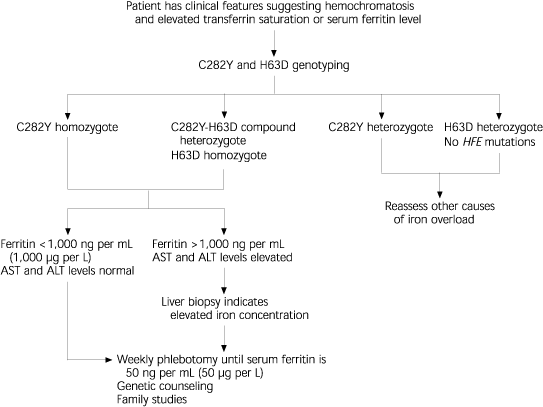
Am Fam Physician. 2003;67(2):402-406
Hemochromatosis is the most common hereditary condition in persons of northern European descent, affecting one in 200 to 300 persons. The perceived rarity of the condition and its vague early symptoms result in many cases not being diagnosed until serious late complications occur because of iron deposition in the tissues. A review by Harrison and Adams stresses the need for a high index of suspicion and the benefits of early screening in all patients at risk, to prevent diabetes, hepatic cirrhosis, cardiomyopathy, and liver cancer.
Hemochromatosis should be suspected in patients with generalized weakness and arthralgias (especially of the hands), because these are early nonspecific symptoms of the condition. It definitely should be included in the differential diagnosis of patients with hepatomegaly, increased levels of aspartate aminotransferase (AST), impotence, infertility, increased skin pigmentation, cardiomyopathy, diabetes types 1 and 2, and cardiac arrhythmias. The other group to be considered for screening includes relatives of patients diagnosed with hemochromatosis.
More than 90 percent of patients clinically diagnosed with hemochromatosis have a mutation on chromosome 6, specifically, a tyrosine substitution for cysteine at amino acid 282. Most of these C282Y cases are homozygous. The remaining cases are mainly caused by a second mutation at amino acid 63 (H63D). Transmission is autosomal recessive, resulting in many heterozygous carriers in the population. Genetic testing should be offered to family members of patients who are discovered to be C282Y homozygotes, even if the index homozygote patient does not have biochemical or clinical evidence of iron overload. Experts estimate that 50 to 90 percent of homozygous persons eventually have at least biochemical indications of iron overload. Women develop signs less commonly and at a later age than men, possibly because of blood loss during reproductive years.
The recommended screening test is determination of serum ferritin and transferrin saturation. Hemochromatosis should be suspected if ferritin levels are 300 ng per mL (300 μg per L) or higher in men and 200 ng per mL (200 μg per L) or higher in women, but ferritin is an acute-phase reactant and can be elevated in several acute conditions. Transferrin saturation is reported to be 94 percent sensitive in diagnosing C282Y hemochromatosis and is most accurate when measured while the patient is fasting. Iron overload is possible at levels of greater than 50 percent in men and greater than 45 percent in women. Genetic testing is recommended by the American Association for the Study of Liver Diseases in all people with abnormal transferrin saturation or ferritin levels and all first-degree relatives of C282Y homozygotes. Siblings of homozygous persons have a one in four chance of being homozygous themselves, and children of homozygous persons have a chance of about one in 20.

Since genetic testing became available, liver biopsy is less important for diagnosis and now is used mainly to establish the presence or absence of cirrhosis. Liver biopsy is considered in C282Y homozygous persons who have liver dysfunction (see accompanying figure) as shown by AST levels greater than 40 U per L or ferritin levels greater than 1,000 ng per mL (1,000 μg per L). Cirrhosis is a serious prognostic finding because phlebotomy does not reverse the cirrhotic process. These patients have a 200-fold increased risk of developing hepatocellular carcinoma.
If detected before organ damage has occurred, regular phlebotomy can maintain ferritin levels in the normal range with improvement in symptoms, lowered morbidity, and normal longevity. Patients also are advised to limit their intake of iron-containing foods and vitamin C.
Although screening is currently recommended only in patients with symptoms suggestive of hemochromatosis or relatives of confirmed cases, evidence is accumulating for general screening of some population groups, and large studies are planned to investigate the ethical, legal, social, and other implications of generalized screening in populations of European descent.